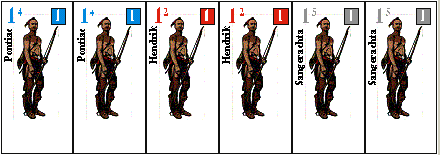Here are a few new leaders to add to Wilderness War. Wilderness War Native Leaders: Three Native leaders are featured in this variant, Pontiac of the Ottawa, King Hendrik of the Mohawk, and the Seneca war leader Sangerachta. In general, Native leaders may command any combination of Indian and auxiliary units, as long as the number of non-Indian units does not exceed the number of Indian units. As well, a Native leader may accompany one individually activated Indian unit at no additional activation cost (and thus may use his Tactics rating when raiding). Specific considerations follow. Pontiac: Activation: 1, Command: 4, Tactics: 1 He rose to become one of the most important leaders of the Ottawa nation. With an Ojibwa mother, however, his influence spread beyond his own tribal affiliation. He was a staunch French ally, and after the French defeat in 1763, he attempted to carry on the war against Anglo-American expansion into the Ohio valley on his own with a coalition of nations, especially the Shawnee and Ottawa. Pontiac can command any French allied Indian units, plus any coureurs as limited by the restrictions above (for example, Pontiac could command any four French allied Indians, three Indians and one coureurs, two Indians and one or two coureurs, one Indian and one coureurs, or one Indian). He begins the 1757 Scenarios in Logstown. In the 1755 scenarios Pontiac begins in Ohio Forks. King Hendrik: Activation: 1, Command: 2, Tactics: 1 The staunchest British ally among the Six Nations, Hendrik was called a "king" as a sign of respect (although the concept of kingship was quite foreign to the Iroquois league). Hendrik was killed in 1755 during the attack on Crown Point. Hendrik can command only the two Mohawk Indian units, or one Mohawk and one ranger (or of course, just one Mohawk). Hendrik is used only in 1755 scenarios, and begins in Albany. Sangerachta: Activation: 1, Command: 5, Tactics: 1 In times of major crisis, the Six Nations would elect two war leaders, traditionally both from the Seneca nation. Sangerachta, an imposing figure standing well over 6 feet tall, was the most respected war leader, and would lead the Six Nations in both this war and the American Revolution. He can command up to five Iroquois Indian units, including both grey and red Mohawk units, or a mixture of Indian and Ranger units subject to the restrictions above if British allied; or if French allied, he can command a combination of five grey Iroquois units and the Caughnawaga unit, or a combination of these Indian units and coureurs subject to the restrictions above. Sangerachta enters the game when the Iroquois Alliance card is used as an event.